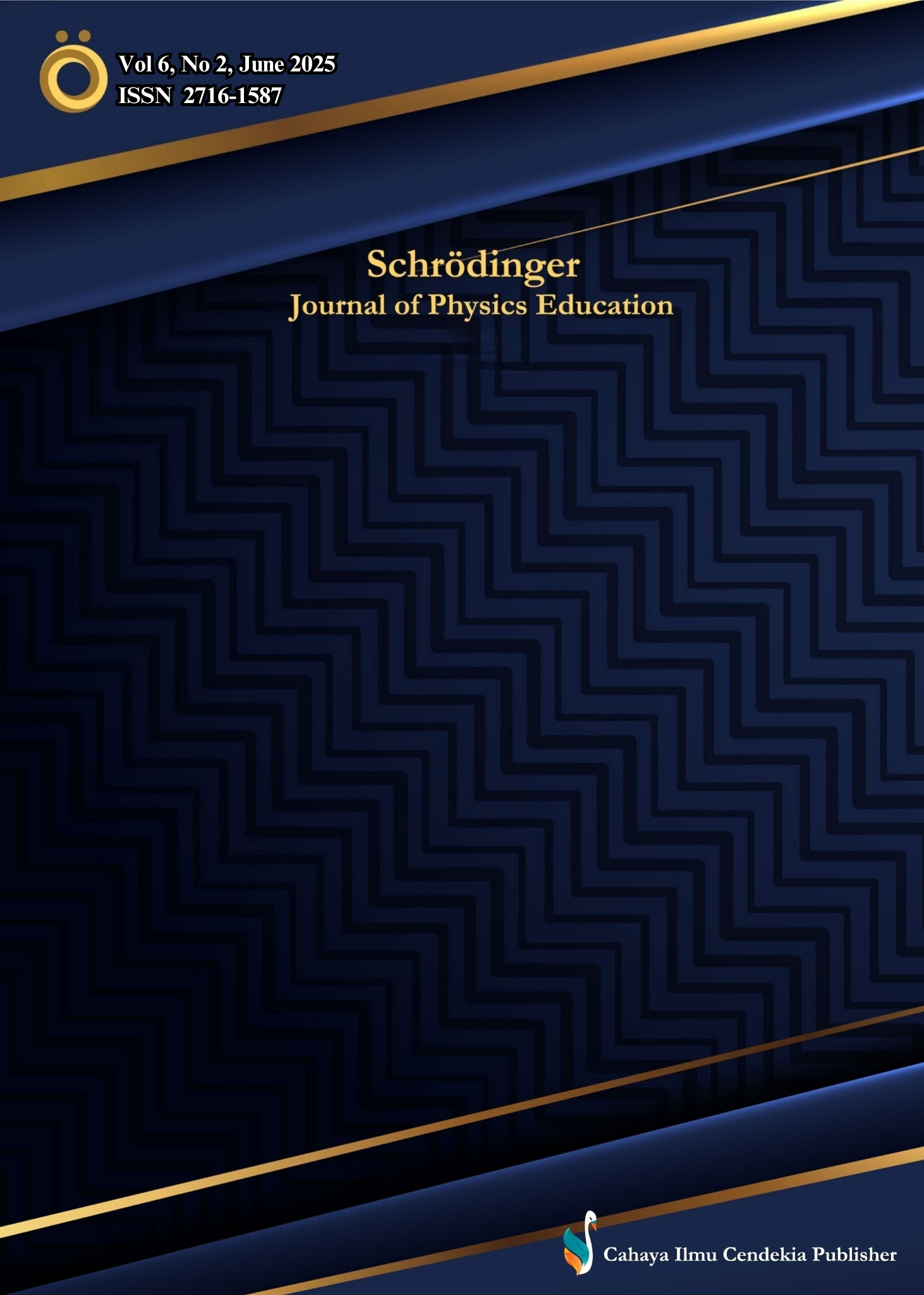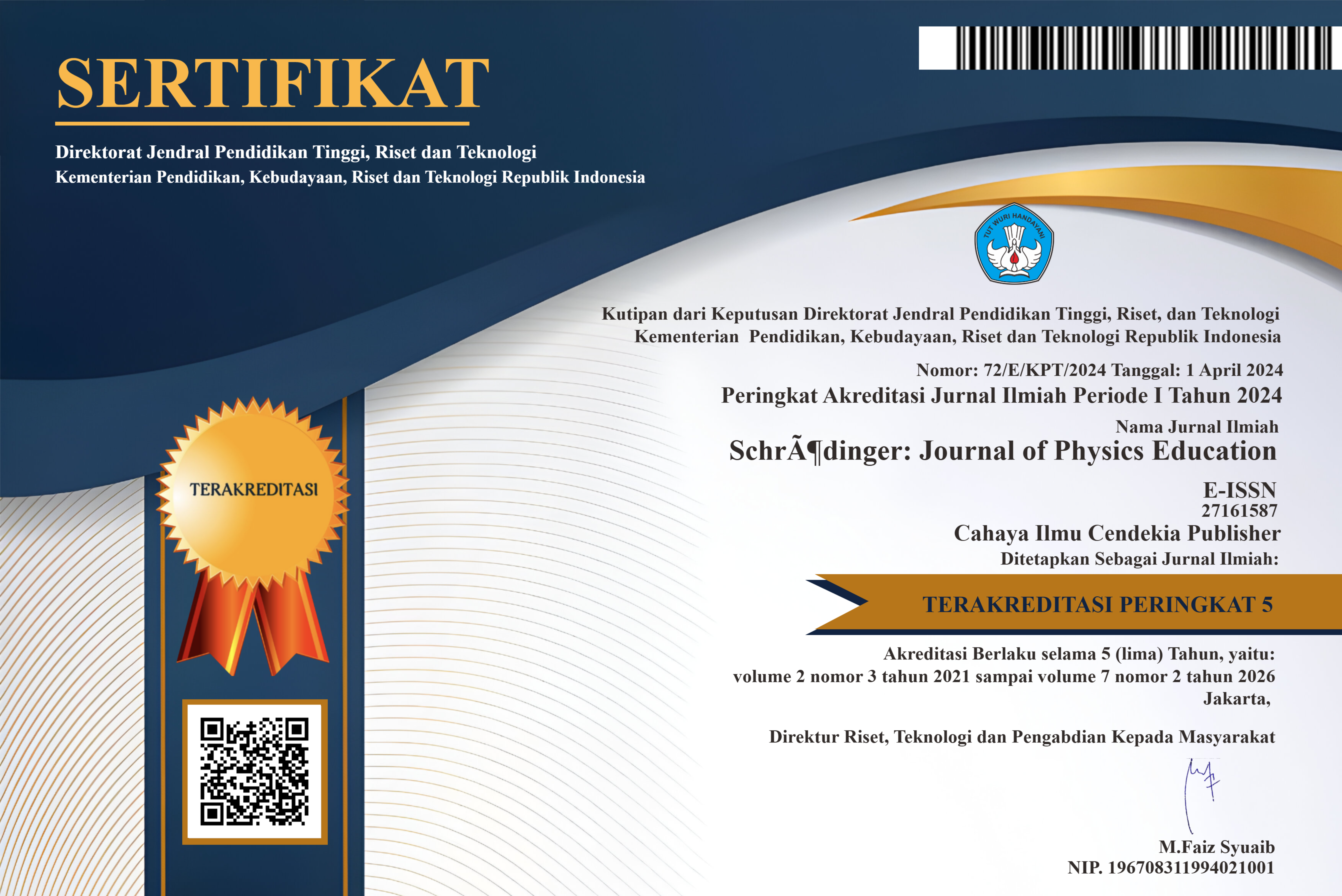Strengthening Student Discipline through Instructional Strategies in Physics Learning: A Naturalistic Study from Four Pedagogical Perspectives
Abstract
Purpose of the study: The purpose of this study is to explore the strategies used by physics teachers in building students' discipline within character education. This study offers theoretical insights into discipline formation and practical guidance for teachers to implement character-based strategies in physics classrooms.
Methodology: This study used a qualitative naturalistic approach with purposive sampling. Data were collected through participatory observation, semi-structured interviews, and documentation. Tools used include observation sheets, interview guides, and field notes. The data were analyzed using the Miles and Huberman interactive model. Validity was ensured through triangulation techniques and member checking for data verification.
Main Findings: The findings show that students' discipline in physics learning was very good. Teachers consistently apply structured strategies, methods, and models that promote punctuality, rule adherence, timely task submission, and practical work discipline. Early communication, consistent rule enforcement, and value reinforcement shaped responsible behavior. Most students felt helped by systematic learning patterns. Teacher strategies were closely linked to students' disciplinary character formation in physics class.
Novelty/Originality of this study: This study offers originality by integrating a naturalistic approach to explore teacher strategies in building student discipline through four instructional perspectives: approach, method, model, and strategy. It advances existing knowledge by highlighting value internalization in physics learning, shifting the focus from formal rule enforcement to reflective classroom practices that naturally foster character-based discipline.
References
K. P. dan Kebudayaan, “Peraturan Menteri Pendidikan dan Kebudayaan Nomor 23 Tahun 2015 tentang Penumbuhan Budi Pekerti [Regulation of the Minister of Education and Culture Number 23 of 2015 concerning the Development of Character],” Jakarta, 2015.
Nurhayati, Jamaris, and Sufyarma Marsidin, “Strengthening pancasila student profiles in independent learning curriculum in elementary school,” Int. J. Humanit. Educ. Soc. Sci., vol. 1, no. 6, pp. 976–988, 2022, doi: 10.55227/ijhess.v1i6.183.
R. Aswidar and S. Z. Saragih, “Karakter religius,toleransi, dan disiplin pada siswa sekolah menengah pertama [Religious character, tolerance, and discipline in junior high school students],” J. Imiah Pendidik. dan Pembelajaran, vol. 6, no. 1, p. 134, 2022, doi: 10.23887/jipp.v6i1.43373.
E. K. Elbes and L. Oktaviani, “Character building in english for daily conversation class materials for english education freshmen students,” J. English Lang. Teach. Learn., vol. 3, no. 1, pp. 36–45, 2022, doi: 10.33365/jeltl.v3i1.1714.
T. Feraco, D. Resnati, D. Fregonese, A. Spoto, and C. Meneghetti, “An integrated model of school students’ academic achievement and life satisfaction. Linking soft skills, extracurricular activities, self-regulated learning, motivation, and emotions,” Eur. J. Psychol. Educ., vol. 38, no. 1, pp. 109–130, 2023, doi: 10.1007/s10212-022-00601-4.
P. R. da S. Fernandes, J. Jardim, and M. C. de S. Lopes, “The soft skills of special education teachers: Evidence from the literature,” Educ. Sci., vol. 11, no. 3, 2021, doi: 10.3390/educsci11030125.
E. Mulyasa, Manajemen pendidikan karakter [Character education management], 1st ed. Jakarta: bumi aksara group, 2022.
P. Mahanani, S. Akbar, A. Y. B. Kamaruddin, and Z. B. Hussin, “Educational analysis to develop character in Malaysia and Indonesia,” Int. J. Instr., vol. 15, no. 3, pp. 377–392, 2022, doi: 10.29333/iji.2022.15321a.
Lukman et al., “Effective teachers’ personality in strengthening character education,” Int. J. Eval. Res. Educ., vol. 10, no. 2, pp. 512–521, 2021, doi: 10.11591/ijere.v10i2.21629.
P. Diana, M. Mulyanis, A. Auliana, S. Safriana, and N. Novita, “Analisis pembentukan karakter remaja dalam pembelajaran fisika di sekolah menengah atas [Analysis of the formation of adolescent character in physics learning in high school],” J. Pendidik. dan Ilmu Fis., vol. 2, no. 1, pp. 109–116, Jun. 2022, doi: 10.52434/jpif.v2i1.1913.
J. Sabaryati, D. A. Pulungan, E. Istiyono, and R. Rosna, “Potret penanaman karakter dalam pembelajaran fisika di sekolah [Portrait of character building in physics learning at school],” J. Educ. Res., vol. 5, no. 2, pp. 2103–2112, 2024, doi: 10.37985/jer.v5i2.1156.
M. F. Adisti, I. K. Werdhiana, M. Zaky, and M. Jarnawi, “Analisis nilai-nilai karakter peserta didik pada pembelajaran fisika di SMA Katolik St. Andreas Palu [Analysis ofstudent character values in physics learning at St. Andreas Catholic High School, Palu],” JPFT (Jurnal Pendidik. Fis. Tadulako Online), vol. 12, no. 1, pp. 1–6, Apr. 2025, doi: 10.22487/jpft.v12i1.3532.
J. P. Dabdoub, D. Salgado, A. Bernal, M. W. Berkowitz, and A. R. Salaverría, “Redesigning schools for effective character education through leadership: The case of PRIMED Institute and vLACE,” J. Moral Educ., vol. 53, no. 3, pp. 558–574, 2024, doi: 10.1080/03057240.2023.2254510.
J. Zhao and X. Liu, “A study on the current status and suggestions of students’ character development education in secondary vocational school,” Cogent Educ., vol. 10, no. 2, 2023, doi: 10.1080/2331186X.2023.2287890.
A. S. Dakhi, Kiat sukses meningkatkan disiplin siswa. Yogyakarta: Deepublish, 2020. [Online]. Available: https://books.google.co.id/books?hl=en&lr=&id=4-ZWEQAAQBAJ&oi=fnd&pg=PP1&dq=Kiat+sukses+meningkatkan+disiplin+siswa&ots=LG8RbeBfyK&sig=M8SR7g9suOFGshuC_3ZguswgAys&redir_esc=y#v=onepage&q=Kiatsuksesmeningkatkandisiplinsiswa&f=false
A. Taufik and M. Akip, “Pembentukan karakter disiplin bagi siswa [Formation of disciplined character for students],” J. Intelekt. J. Pendidik. dan Stud. Keislam., vol. 11, no. 2, pp. 122–136, 2021, doi: 10.33367/ji.v11i2.1674.
Herpratiwi and A. Tohir, “Learning interest and discipline on learning motivation,” Int. J. Educ. Math. Sci. Technol., vol. 10, no. 2, pp. 424–435, 2022, doi: 10.46328/ijemst.2290.
A. Ibrahim and W. El Zataari, “The teacher–student relationship and adolescents’ sense of school belonging,” Int. J. Adolesc. Youth, vol. 25, no. 1, pp. 382–395, 2020, doi: 10.1080/02673843.2019.1660998.
S. Simkins and M. Maier, Just in time teaching: across the disciplines, and across the academy, 1st ed. New York: Holt, Rinehart and Winston: Taylor & Francis, 2023. doi: 10.4324/9781003445517.
E. Khaidir and F. M. Suud, “Islamic education in forming students’ characters at As-shofa islamic high school, Pekanbaru Riau,” Int. J. Islam. Educ. Psychol., vol. 1, no. 1, pp. 50–63, 2020, doi: 10.18196/ijiep.1105.
R. A. Nadila and A. Aeni, “Implementasi profil pelajar Pancasila peserta didik kelas IV SD negeri Randugunting 7 Kota Tegal [Implementasi profil pelajar pancasila peserta didik kelas IV SD negeri Randugunting 7 Kota Tegal],” J. Elem. Educ., vol. 12, no. 1, pp. 1–9, 2023, [Online]. Available: https://journal.unnes.ac.id/sju/index.php/jee/article/view/69466
S. Tanjung, R. W. Nita, and Y. Chandra, “Design of information service model based on identification of disciplinary behavior of class F students at SMA N 4 Sumatera Barat (sports talent),” J. Nas. Holist. Sci., vol. 4, no. 3, pp. 516–522, 2024, [Online]. Available: https://jurnal.larisma.or.id/index.php/HS
A. Suprayitno and W. Wahyudi, Pendidikan Karakter di Era Milenial [Character Education in the Millennial Era], 1st ed. Yogyakarta: Deepublish, 2020. [Online]. Available: https://books.google.co.id/books?hl=en&lr=&id=ovhZEQAAQBAJ&oi=fnd&pg=PP1&dq=A.+Suprayitno+and+W.+Wahyudi,+Pendidikan+karakter+di+era+milenial,+1st+ed&ots=JtrqTZ8C4y&sig=trXGEYtw8Pnt2qkvPVpXDk1WGj0&redir_esc=y#v=onepage&q&f=false
H. A. Reijers, “Business process management: The evolution of a discipline,” Comput. Ind., vol. 126, p. 103404, 2021, doi: 10.1016/j.compind.2021.103404.
L. A. Rodriguez and R. O. Welsh, “The dimensions of school discipline: Toward a comprehensive framework for measuring discipline patterns and outcomes in schools,” AERA Open, vol. 8, no. 1, pp. 1–23, 2022, doi: 10.1177/23328584221083669.
P. Senjaya, F. Kotamena, F. Ong, C. B. Andika, A. Purwanto, and R. Pramono, “School environmental influences, student discipline and learning motivation toward increasing senior high students achievement,” Int. J. Adv. Sci. Technol., vol. 29, no. 5, pp. 4572–4586, 2020, [Online]. Available: https://ssrn.com/abstract=3985889
N. Çırakoğlu, S. E. Toksoy, and İ. Reisoğlu, “Designing, developing, and evaluating an interactive e-book based on the Predict-Observe-Explain (POE) Method,” J. Form. Des. Learn., vol. 6, no. 2, pp. 95–112, 2022, doi: 10.1007/s41686-022-00071-3.
M. Coccia, “The evolution of scientific disciplines in applied sciences: dynamics and empirical properties of experimental physics,” Scientometrics, vol. 124, no. 1, pp. 451–487, 2020, doi: 10.1007/s11192-020-03464-y.
K. P. Tripathy and A. K. Mishra, “Deep learning in hydrology and water resources disciplines: Concepts, methods, applications, and research directions,” J. Hydrol., vol. 628, p. 130458, 2024, doi: 10.1016/j.jhydrol.2023.130458.
I. Sofiasyari, “Implementasi pendidikan karakter dalam pembelajaran tematik di kelas IV sekolah dasar Kota Semarang [Implementation of character education in thematic learning in grade IV elementary schools in Semarang City],” Universitas Negeri Semarang, 2020. [Online]. Available: https://lib.unnes.ac.id/40919/1/tesisfull.pdf
R. W. Ningrum, E. A. Ismaya, and N. Fajrie, “Faktor – faktor pembentuk karakter disiplin dan tanggung jawab dalam ekstrakurikuler pramuka [Factors that form the character of discipline and responsibility in scouting extracurricular activities],” J. Prakarsa Paedagog., vol. 3, no. 1, 2020, doi: 10.24176/jpp.v3i1.5105.
C. Mercader and J. Gairín, “University teachers’ perception of barriers to the use of digital technologies: the importance of the academic discipline,” Int. J. Educ. Technol. High. Educ., vol. 17, no. 1, 2020, doi: 10.1186/s41239-020-0182-x.
F. Multazam and O. Setiasih, “Analisis kebijakan profil pelajar pancasila terhadap internalisasi pendidikan karakter anak usia dini [Analysis of Pancasila student profile policy on the internalization of early childhood character education],” Aulad J. Early Child., vol. 6, no. 1, pp. 61–67, 2023, doi: 10.31004/aulad.v6i1.463.
M. B. Simanjuntak, “The educational values of the main character in beautiful mind film,” J. Adv. English Stud., vol. 3, no. 1, p. 1, 2020, doi: 10.47354/jaes.v3i1.83.
W. Birhan, G. Shiferaw, A. Amsalu, M. Tamiru, and H. Tiruye, “Exploring the context of teaching character education to children in preprimary and primary schools,” Soc. Sci. Humanit. Open, vol. 4, no. 1, p. 100171, 2021, doi: 10.1016/j.ssaho.2021.100171.
R. P. Harianto, L. Zakiah, and M. S. Sumantri, “Tingkat kedisiplinan belajar terhadap prestasi belajar siswa [Level of learning discipline towards student learning achievement],” J. Ilm. Pendidik. Dasar, vol. 9, pp. 165–173, 2024, doi: 10.23969/jp.v9i2.13197.
N. Rohmah, S. Hidayat, and L. Nulhakim, “Implementasi pendidikan karakter disiplin dalam mendukung layanan kualitas belajar siswa [Implementation of disciplined character education in supporting student learning quality services],” J. Imiah Pendidik. dan Pembelajaran, vol. 5, no. 1, p. 150, 2021, doi: 10.23887/jipp.v5i1.30308.
I. N. Sari et al., Metode penelitian kualitatif [Qualitative research methods]. Malang: UNISMA PRESS, 2022. [Online]. Available: https://books.google.co.id/books?hl=en&lr=&id=iCZlEAAAQBAJ&oi=fnd&pg=PA1&dq=Metode+penelitian+kualitatif&ots=opdDMvBZWe&sig=GwcZf83kbz2S2WSZcc8cAJVwMRE&redir_esc=y#v=onepage&q=Metodepenelitiankualitatif&f=false
E. Setiawan, Fitri Silvia Sofyan, and Lusiana Rahmatiani, “Teachers’ efforts to improve students’ critical thinking skills At Al-Ikhwan it Junior High School,” J. Civ. Soc. Stud., vol. 8, no. 1, pp. 104–110, 2024, doi: 10.31980/journalcss.v8i1.1515.
L. Doyle, C. McCabe, B. Keogh, A. Brady, and M. McCann, “An overview of the qualitative descriptive design within nursing research,” J. Res. Nurs., vol. 25, no. 5, pp. 443–455, 2020, doi: 10.1177/1744987119880234.
L. Given, “Purposive sampling,” SAGE Encycl. Qual. Res. Methods, vol. 2, no. December, pp. 1–9, 2012, doi: 10.4135/9781412963909.n349.
M. B. Miles, A. M. Huberman, and J. Saldana, Qualitative data analysis: A methods sourcebook, 3rd ed. Amerika: SAGE Publications, 2013.
D. Susanto, Risnita, and M. S. Jailani, “Teknik pemeriksaan keabsahan data dalam penelitian ilmiah [Data validity checking techniques in scientific research],” J. QOSIM J. Pendidik. Sos. Hum., vol. 1, no. 1, pp. 53–61, 2023, doi: 10.61104/jq.v1i1.60.
E. Zelčāne and A. Pipere, “Finding a path in a methodological jungle: a qualitative research of resilience,” Int. J. Qual. Stud. Health Well-being, vol. 18, no. 1, 2023, doi: 10.1080/17482631.2023.2164948.
A. Yustina, M. M. I. Susanti, and M. I. Rustamti., “Peningkatan kedisiplinan dan keterampilan berpikir kritis melalui pendekatan kontekstual [Improving discipline and critical thinking skills through a contextual approach],” Elem. J. Inov. Pendidik. Dasar, vol. 1, no. 3, pp. 58–65, 2021, doi: 10.51878/elementary.v1i3.297.
D. R. Wulandari, A. C. Apriliana, and T. Setiawati, “Upaya meningkatkan aktivitas dan hasil belajar siswa pada pembelajaran Ilmu Pengetahuan Alam (IPA) materi perubahan wujud benda melalui metode demonstrasi [Efforts to improve student activity and learning outcomes in Natural Sciences (IPA) learning on cha,” Sebel. April Elem. Educ., vol. 1, no. 3, pp. 10–18, 2022, [Online]. Available: https://ejournal.lppmunsap.org/index.php/saee/article/view/449
R. Hanifah, D. A. Soleh, and Y. Suntari, “Pembentukan sikap tanggung jawab siswa melalui model problem based learning di sekolah dasar [shaping students’ responsibility through the problem-based learning method in elementary school],” Polyglot J. Ilm., vol. 19, no. 2, p. 90, 2023, doi: 10.19166/pji.v19i2.6111.
H. Handayani, “Manajemen peserta didik dalam meningkatkan kedisiplinan siswa di SMAN 1 Pringgabaya [Student management in improving student discipline at SMAN 1 Pringgabaya],” J. Manaj. dan Budaya, vol. 2, no. 2, pp. 17–32, 2022, doi: 10.51700/manajemen.v2i2.339.
Copyright (c) 2025 Diah Sari Dewi, Evi Ramna Farni, Sri Suryati

This work is licensed under a Creative Commons Attribution 4.0 International License.
Authors who publish with this journal agree to the following terms:
- Authors retain copyright and acknowledge that the Schrödinger: Journal of Physics Education is the first publisher licensed under a Creative Commons Attribution 4.0 International License.
- Authors are able to enter into separate, additional contractual arrangements for the non-exclusive distribution of the journal's published version of the work (e.g., post it to an institutional repository or publish it in a book), with an acknowledgment of its initial publication in this journal.
- Authors are permitted and encouraged to post their work online (e.g., in institutional repositories or on their website) prior to and during the submission process, as it can lead to productive exchanges and earlier and greater citation of published work.







.png)
.png)








.png)
.png)
.png)







